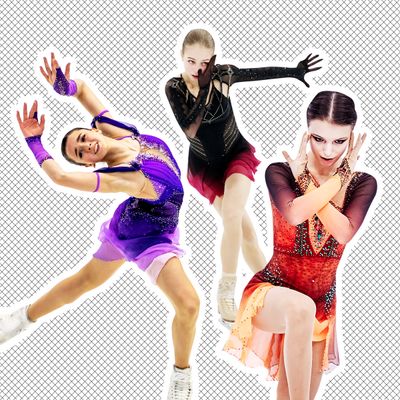
At this year’s Russian national figure-skating championships, Alina Zagitova and Evgenia Medvedeva, the gold and silver medalists from the 2018 Winter Olympics, sat near the edge of the rink, one in a blue pantsuit, the other in a snowflake-patterned sweater — civilian clothes — consigned to retirement at the ages of 19 and 22. Injuries and burnout had sidelined the athletes, but their once-impressive arsenals of triple jumps would have likely failed to qualify them for the 2022 Olympic team.
The past four years have given rise to an extraordinary leap forward in the sport, as a new crop of Russian skaters (and a couple from elsewhere) master a range of quadruple jumps. As of now, no quad has been completed by a woman in an Olympic competition, but that’s about to change. If you haven’t watched figure skating since the last Olympics, buckle up.
Covering their nationals for Russia’s Channel One, Zagitova and Medvedeva watched a field of skaters planning a collective 15 quadruple jumps in their free skates (rules prohibit quads in the short program). Alexandra Trusova was capable of landing five in a single program. On this day, she landed three. Four others landed at least one. In total, the skaters landed 11 quads. The teenage medalists, Olympic favorite Kamila Valieva, Trusova, and reigning world champion Anna Shcherbakova, will almost certainly sweep the podium in Beijing.
The American skater Mirai Nagasu, the only woman to land the difficult triple axel in the 2018 Olympics, shares in the sense of disbelief at how the sport’s expectations have ballooned. “To look at the field now compared to four years ago,” she told me, “the expectation that the women who are winning medals will have, at a minimum, one quad, is a little bit unfathomable.”
How did the unfathomable come to pass? The equipment itself has seen modest improvements over the past couple of decades: lighter boots, refined blades. But really it all started with the 2004 decision by the International Skating Union to scrap the traditional 6.0 scoring system for one in which elements are assigned a base score, with skaters earning positive or negative grades of execution for each attempt. If you have no idea what I’m talking about, know this: Under this system, the base score of, say, a triple toe loop is 4.2 — a quad toe loop is 9.5.
Scott Hamilton, the 1984 Olympic champion and longtime television commentator, believes that the new system better rewards excellence. “It’s an incentive,” he says. “Skaters are growing up with it, and they’re building their skating to accommodate it.”
Over a generation of chasing higher base scores, skaters and their coaches gradually discovered the new techniques that would eventually enable quads.
“The way I was taught to jump and to rotate is way different than the way they’re being taught to jump and rotate now,” explains Hamilton. In his competitive days, skaters learned to jump up and establish themselves in the air, then rotate. “It was a delayed rotation. Now, if you’re not rotating the second you leave the ice, you’re behind the times.”
Nagasu notes that in successful quad jumps the rotation of the upper body begins even before takeoff: “They’re already half a turn rotated, because that allows for the snap.”
Nowhere has this technique been harnessed to greater effect than at the Sambo 70 training center in Moscow, where the severely glamorous coach Eteri Tutberidze oversees a seemingly bottomless well of young skaters capable of perfecting quad jumps, ever since Trusova and Shcherbakova began performing them on the junior level in 2018. Tutberidze coaches all three of this year’s Russian Olympians. (She also coached Zagitova and Medvedeva to their Olympic medals.)
“She has such a huge school and she has so many skaters to choose from,” says Hamilton. “When you have that many people coming through your program and you have the technique … you’re going to be at a distinct advantage over the rest of the world.”
Nagasu sees another advantage at Sambo 70. “If someone can do it around you, it makes it so much easier to believe that you can do it,” she says. “Once you’re seeing it happen, that timing is getting ingrained in your body.”
Given Russia’s history with doping at the Olympics, the possible involvement of performance-enhancing drugs bears mentioning, although there has been no evidence of it in the current skaters. (Adelina Sotnikova, the 2014 Olympic champion, was investigated as part of the inquiry into the widespread doping coverup by Russia at the Sochi games. Her case was closed with no charges, while 13 other Russian athletes were stripped of their medals.)
This era’s Russian triumphs might lead American audiences to wonder where the once-dominant U.S. women stand. I asked Hamilton and Nagasu if they think the Americans can catch up in the quad race anytime soon.
Both have their doubts. Training the quad jumps can be incredibly hard on the body, and Nagasu points to the newfound emphasis on mental and physical health among U.S. athletes, who may no longer be willing to risk long-term injury and mental stress for one competition. “That makes the U.S. such a different country than Russia,” she says. “But it’s hard to say which is better, because at this current stage in time, I feel like a balance would be better.”
Hamilton says the Americans would need to create “an atmosphere and a participation that is comparable” to what Tutberidze has done in Russia. “And then yes, absolutely,” he says. “I don’t see that happening anytime soon, though.”
For this Olympics, at least, best to simply give in to astonishment as the Russian women take the ice and make the unfathomable appear commonplace.




